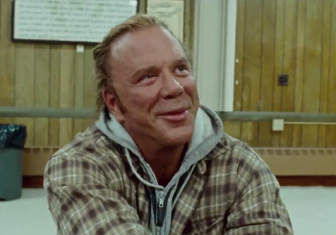Chapter 6: Introduction
Camera Skills
6
CHAPTER
“The excellence of the image really has to come from the excellence of the intent.”
– Christopher Doyle, cinematographer for over 60 films, including Hero (2002)

The Wrestler (2005)
KEY CONCEPTS
 The screens on which your film may be seen—including movie and TV screens—have specific height-to-width ratios, so you will need to “shoot to fit” and sometimes make allowances for different sizes.
The screens on which your film may be seen—including movie and TV screens—have specific height-to-width ratios, so you will need to “shoot to fit” and sometimes make allowances for different sizes. Digital cameras capture images electronically with optical sensors and record their images on a variety of media, such as SD cards and hard drives.
Digital cameras capture images electronically with optical sensors and record their images on a variety of media, such as SD cards and hard drives. Film cameras capture images through a photochemical and mechanical process and record their images onto reels of celluloid.
Film cameras capture images through a photochemical and mechanical process and record their images onto reels of celluloid. All cameras need lenses to capture light and place it on a recording medium, and different lenses bend light in unique ways, allowing for an almost infinite amount of ways to compose images.
All cameras need lenses to capture light and place it on a recording medium, and different lenses bend light in unique ways, allowing for an almost infinite amount of ways to compose images. Accessories that support and move the camera are fundamental tools that let you capture action in the most compelling cinematic way.
Accessories that support and move the camera are fundamental tools that let you capture action in the most compelling cinematic way.
Maryse Alberti started having serious fun with cameras when she was 12, and by the time she grew up to be a cinematographer, she’d played with every kind of camera she could get her hands on. But when director Darren Aronofsky asked her to shoot The Wrestler (2005), she wasn’t sure what kind of camera she should use.
The story of a washed-up wrestler looking for a comeback had to be gritty and tough, but the wrestling scenes would be highly choreographed. “I was willing to work very simply, and Darren wanted to give a lot of freedom to the actors,”1 Alberti said; therefore the camera and lighting couldn’t get in the way. Although Aronofsky needed the camera to get close to the action and follow it effortlessly, the film still had to look like a movie, not a haphazard video; it needed the feel of cinema—a dark moodiness, textured lighting, and compelling, memorable images.
What camera did Alberti work with? A Super 16mm film camera: the workhorse of student films before the digital revolution, and a format that was invented nearly one hundred years ago.2 Lightweight and flexible, a 16mm camera is easy to hold in your hands, and you can move it naturally, mimicking the movement of turning your head to see something when it catches your attention.
What camera would Alberti use on her next movie? That would depend on the movie. “I’m there to serve the story,”3 she says.
Like Maryse Alberti, you have likely been exposed to cameras since you were young, and today the camera in your smart phone is your constant companion. Now it’s time to expand your knowledge in two important ways. You’re about to learn how to use different tools on more sophisticated cameras, and you’ll discover how to use cameras with greater intent—the premeditation that comes from carefully conceiving the story you want to tell, designing an ideal series of shots to convey that story, and figuring out how to achieve those shots with different image capture tools.
In this chapter, you’ll study the process of image capture and learn which details you need to iron out before you begin shooting. In doing so, you’ll examine aspect ratios—one of the hard-and-fast specifications of the filmmaking craft that is rarely discussed but crucial to the final outcome of your effort. Next you’ll explore the different screens on which your movie may be seen—everything from a movie screen to a television to a laptop to a mobile phone. With an understanding that the final product—what will be on the screen—is what you’re after, you’ll move to the start of the process: how to acquire the images you will eventually see on a screen or screens of differing formats. Digital technologies and film are two recording media on which images can be captured and stored; you’ll discover how they work, and evaluate the cameras and systems that produce visual images. You’ll also learn about lenses, which change the way shots look, and examine the equipment you can use to support and move the camera.
The five key concepts on the previous page are what you’ll need to understand if you choose to become a cinematographer or director of photography (DP)—interchangeable terms for the person ultimately responsible for making sure a movie is properly photographed.